Factors Influencing Rental Housing Prices in the UK: An Analysis
VerifiedAdded on 2023/01/12
|10
|2987
|47
Report
AI Summary
This report provides an in-depth analysis of the UK rental housing market, examining the key factors that influence rental prices. The report begins with an introduction to economics, focusing on demand and supply analysis and its application to the housing market. It identifies the main factors determining rental prices, including property characteristics, income levels, population density, and income inequality. The analysis also explores the impact of government policies on the rental housing market, such as social housing programs and affordable rental initiatives. The report uses economic principles to explain how these factors and policies affect the demand and supply of rental properties, ultimately influencing affordability and market dynamics. The report concludes by summarizing the key findings and implications for the UK rental housing sector.
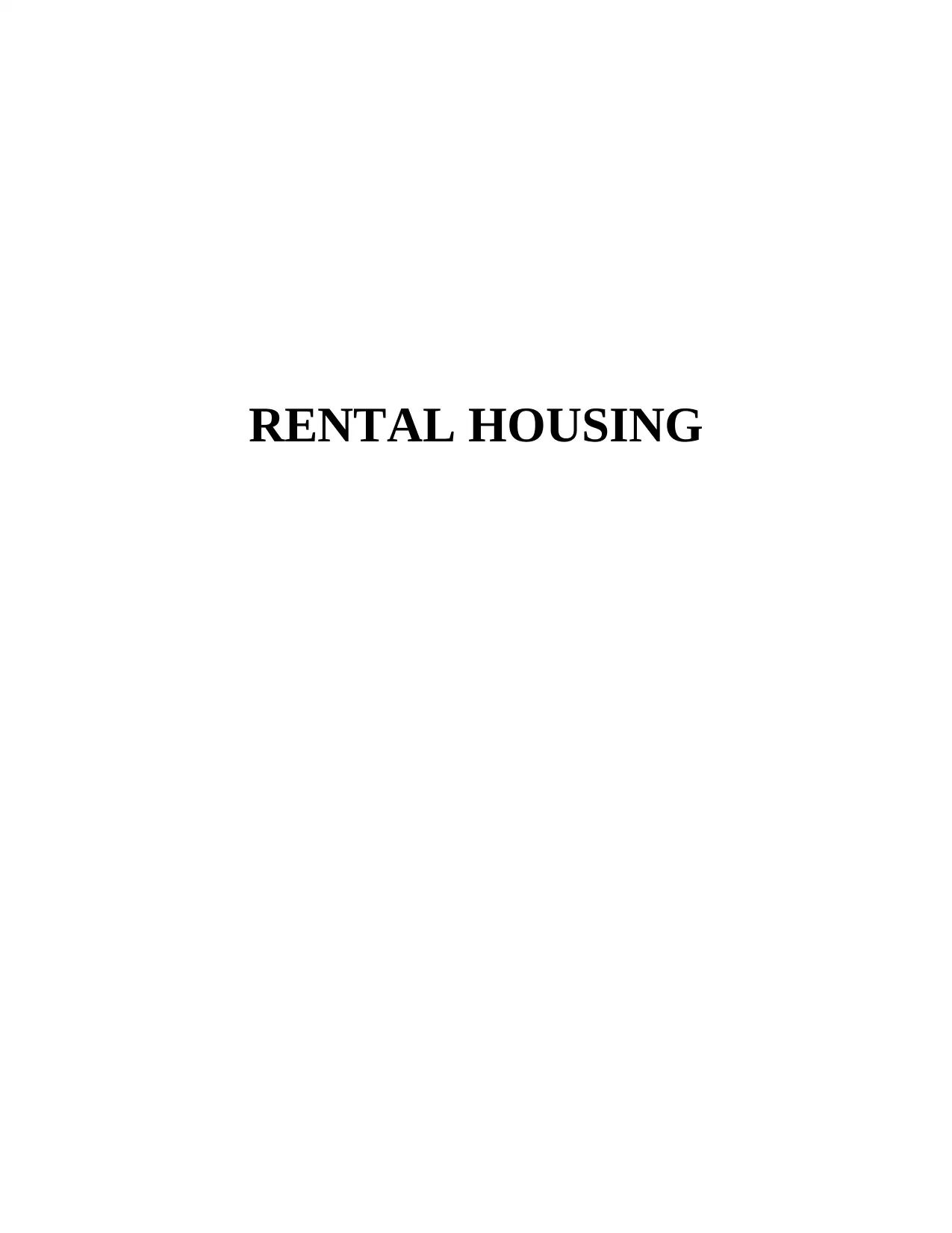
RENTAL HOUSING
Paraphrase This Document
Need a fresh take? Get an instant paraphrase of this document with our AI Paraphraser

TABLE OF CONTENTS
INTRODUCTION...........................................................................................................................1
TASK 1............................................................................................................................................1
Using demand and supply analysis identify main factors determining prices of rental housing
in UK. ..........................................................................................................................................1
TASK 2............................................................................................................................................5
Identifying and explaining main economic/government policies that will be used for
influencing demand for the private rental housing .....................................................................5
CONCLUSION ...............................................................................................................................7
REFERENCES................................................................................................................................9
INTRODUCTION...........................................................................................................................1
TASK 1............................................................................................................................................1
Using demand and supply analysis identify main factors determining prices of rental housing
in UK. ..........................................................................................................................................1
TASK 2............................................................................................................................................5
Identifying and explaining main economic/government policies that will be used for
influencing demand for the private rental housing .....................................................................5
CONCLUSION ...............................................................................................................................7
REFERENCES................................................................................................................................9

INTRODUCTION
Economics is defined as the study of distribution, production and consumption. It is
divided in two main categories that are microeconomics and macroeconomics. Macroeconomics
deal with the aggregate quantity like outputs & national income. Roots are connected with
microeconomics that factors such as market and the decision-making process of the individual
economic units. It is the starting point to economics. Demand & supply analysis refers to the
study of buyers & sellers interacting for determining the transaction prices & quantities. Prices
have effect over both the values to buyer of next unit and costs to seller of the unit. The report is
based over the government and economic policies which could be used for influencing demand
for the private rental housing in UK. Report will cover the demand and supply analysis with
factors determining the prices for rental property in UK. It will also provide about the
government policies which could be used for influencing demand for rental housing.
TASK 1
Using demand and supply analysis identify main factors determining prices of rental housing in
UK.
In UK privately owned properties are either leasehold or freehold. Freehold refers to the
land and property owned on land. Leasehold refers to the property that is not owned and rights
of using the property and land are reserved by the owners of property. Under the rented
properties, landlords rent their property by the tenancy agreements for specified period of time,
which can be renewed. Monthly rent is paid by tenants, throughout the renting period. This is
helping the household section to grow more efficiently and effectively. There are several factors
that are responsible in determining the prices of the rental housing property.
As per the government informations millions of people are spending above half of their
incomes for covering rents or mortgage. Supply of the affordable units declines, as landlords
have found it more profitable in converting their governments subsidized properties into the
apartments and condominiums at the market rate (Delgado, 2016). It is reviewed that majority of
people spend 30 % of their income on housing. Government programmes have helped the
economy to secure the affordable housing.
Housing market is different from that of the products market due to various reasons,
including durability, immobility and different features like location size and the floor plan. Due
to the heterogeneous & immobile nature of housing market it is split into number of sub-markets
1
Economics is defined as the study of distribution, production and consumption. It is
divided in two main categories that are microeconomics and macroeconomics. Macroeconomics
deal with the aggregate quantity like outputs & national income. Roots are connected with
microeconomics that factors such as market and the decision-making process of the individual
economic units. It is the starting point to economics. Demand & supply analysis refers to the
study of buyers & sellers interacting for determining the transaction prices & quantities. Prices
have effect over both the values to buyer of next unit and costs to seller of the unit. The report is
based over the government and economic policies which could be used for influencing demand
for the private rental housing in UK. Report will cover the demand and supply analysis with
factors determining the prices for rental property in UK. It will also provide about the
government policies which could be used for influencing demand for rental housing.
TASK 1
Using demand and supply analysis identify main factors determining prices of rental housing in
UK.
In UK privately owned properties are either leasehold or freehold. Freehold refers to the
land and property owned on land. Leasehold refers to the property that is not owned and rights
of using the property and land are reserved by the owners of property. Under the rented
properties, landlords rent their property by the tenancy agreements for specified period of time,
which can be renewed. Monthly rent is paid by tenants, throughout the renting period. This is
helping the household section to grow more efficiently and effectively. There are several factors
that are responsible in determining the prices of the rental housing property.
As per the government informations millions of people are spending above half of their
incomes for covering rents or mortgage. Supply of the affordable units declines, as landlords
have found it more profitable in converting their governments subsidized properties into the
apartments and condominiums at the market rate (Delgado, 2016). It is reviewed that majority of
people spend 30 % of their income on housing. Government programmes have helped the
economy to secure the affordable housing.
Housing market is different from that of the products market due to various reasons,
including durability, immobility and different features like location size and the floor plan. Due
to the heterogeneous & immobile nature of housing market it is split into number of sub-markets
1
⊘ This is a preview!⊘
Do you want full access?
Subscribe today to unlock all pages.

Trusted by 1+ million students worldwide
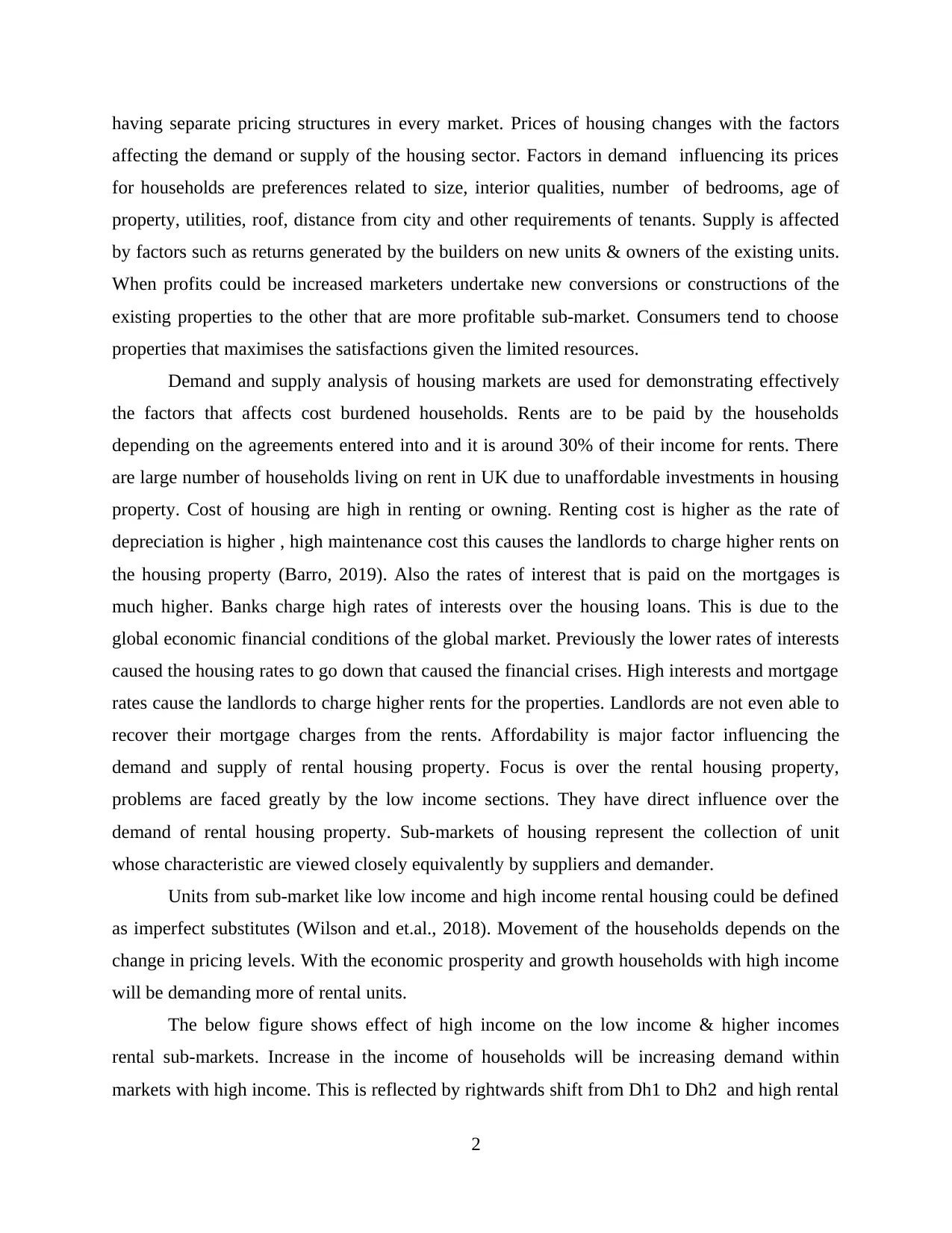
having separate pricing structures in every market. Prices of housing changes with the factors
affecting the demand or supply of the housing sector. Factors in demand influencing its prices
for households are preferences related to size, interior qualities, number of bedrooms, age of
property, utilities, roof, distance from city and other requirements of tenants. Supply is affected
by factors such as returns generated by the builders on new units & owners of the existing units.
When profits could be increased marketers undertake new conversions or constructions of the
existing properties to the other that are more profitable sub-market. Consumers tend to choose
properties that maximises the satisfactions given the limited resources.
Demand and supply analysis of housing markets are used for demonstrating effectively
the factors that affects cost burdened households. Rents are to be paid by the households
depending on the agreements entered into and it is around 30% of their income for rents. There
are large number of households living on rent in UK due to unaffordable investments in housing
property. Cost of housing are high in renting or owning. Renting cost is higher as the rate of
depreciation is higher , high maintenance cost this causes the landlords to charge higher rents on
the housing property (Barro, 2019). Also the rates of interest that is paid on the mortgages is
much higher. Banks charge high rates of interests over the housing loans. This is due to the
global economic financial conditions of the global market. Previously the lower rates of interests
caused the housing rates to go down that caused the financial crises. High interests and mortgage
rates cause the landlords to charge higher rents for the properties. Landlords are not even able to
recover their mortgage charges from the rents. Affordability is major factor influencing the
demand and supply of rental housing property. Focus is over the rental housing property,
problems are faced greatly by the low income sections. They have direct influence over the
demand of rental housing property. Sub-markets of housing represent the collection of unit
whose characteristic are viewed closely equivalently by suppliers and demander.
Units from sub-market like low income and high income rental housing could be defined
as imperfect substitutes (Wilson and et.al., 2018). Movement of the households depends on the
change in pricing levels. With the economic prosperity and growth households with high income
will be demanding more of rental units.
The below figure shows effect of high income on the low income & higher incomes
rental sub-markets. Increase in the income of households will be increasing demand within
markets with high income. This is reflected by rightwards shift from Dh1 to Dh2 and high rental
2
affecting the demand or supply of the housing sector. Factors in demand influencing its prices
for households are preferences related to size, interior qualities, number of bedrooms, age of
property, utilities, roof, distance from city and other requirements of tenants. Supply is affected
by factors such as returns generated by the builders on new units & owners of the existing units.
When profits could be increased marketers undertake new conversions or constructions of the
existing properties to the other that are more profitable sub-market. Consumers tend to choose
properties that maximises the satisfactions given the limited resources.
Demand and supply analysis of housing markets are used for demonstrating effectively
the factors that affects cost burdened households. Rents are to be paid by the households
depending on the agreements entered into and it is around 30% of their income for rents. There
are large number of households living on rent in UK due to unaffordable investments in housing
property. Cost of housing are high in renting or owning. Renting cost is higher as the rate of
depreciation is higher , high maintenance cost this causes the landlords to charge higher rents on
the housing property (Barro, 2019). Also the rates of interest that is paid on the mortgages is
much higher. Banks charge high rates of interests over the housing loans. This is due to the
global economic financial conditions of the global market. Previously the lower rates of interests
caused the housing rates to go down that caused the financial crises. High interests and mortgage
rates cause the landlords to charge higher rents for the properties. Landlords are not even able to
recover their mortgage charges from the rents. Affordability is major factor influencing the
demand and supply of rental housing property. Focus is over the rental housing property,
problems are faced greatly by the low income sections. They have direct influence over the
demand of rental housing property. Sub-markets of housing represent the collection of unit
whose characteristic are viewed closely equivalently by suppliers and demander.
Units from sub-market like low income and high income rental housing could be defined
as imperfect substitutes (Wilson and et.al., 2018). Movement of the households depends on the
change in pricing levels. With the economic prosperity and growth households with high income
will be demanding more of rental units.
The below figure shows effect of high income on the low income & higher incomes
rental sub-markets. Increase in the income of households will be increasing demand within
markets with high income. This is reflected by rightwards shift from Dh1 to Dh2 and high rental
2
Paraphrase This Document
Need a fresh take? Get an instant paraphrase of this document with our AI Paraphraser

rates. In market of low income landlord finds it profitable for converting the units with low
income to units with higher income because of high rental rate in higher income market. This
causes supply if market with low income to shift from SL1 to SL2 as the resources moved and
quantity supplied in the units with high income increases. This is seen by the movement in
supply curve to QH2. Equilibrium is reached by market with increase in rental units with higher
incomes, decrease in rental units with low income and high rates of rent in the two sub-markets.
Percentage of the cost burdened household will increase with high rental rates, generally from
the families which are not benefited from the high tech new economy.
Factors influencing the urban rental housing on demand side includes incomes,
population density and growth, unemployment rates, degree of inequality, gap between rich &
poor. As the per capita income of households increases they demand more higher quality, this
increases the rent on units with lower income. Increase in rent increases the burden over
households.
Increase in unemployment decrease demand for the rental units both in high and lower
income markets. This also caused the unemployed to have decreased income in relation with
median income. Higher unemployment reduces demand and prices of the rental housing and also
the burden faced for acquiring the rental units will increase.
Growth of population and density have significant consequences over availability of the
rental units. Increase in population causes the demand to grow and also cost burdened
3
income to units with higher income because of high rental rate in higher income market. This
causes supply if market with low income to shift from SL1 to SL2 as the resources moved and
quantity supplied in the units with high income increases. This is seen by the movement in
supply curve to QH2. Equilibrium is reached by market with increase in rental units with higher
incomes, decrease in rental units with low income and high rates of rent in the two sub-markets.
Percentage of the cost burdened household will increase with high rental rates, generally from
the families which are not benefited from the high tech new economy.
Factors influencing the urban rental housing on demand side includes incomes,
population density and growth, unemployment rates, degree of inequality, gap between rich &
poor. As the per capita income of households increases they demand more higher quality, this
increases the rent on units with lower income. Increase in rent increases the burden over
households.
Increase in unemployment decrease demand for the rental units both in high and lower
income markets. This also caused the unemployed to have decreased income in relation with
median income. Higher unemployment reduces demand and prices of the rental housing and also
the burden faced for acquiring the rental units will increase.
Growth of population and density have significant consequences over availability of the
rental units. Increase in population causes the demand to grow and also cost burdened
3
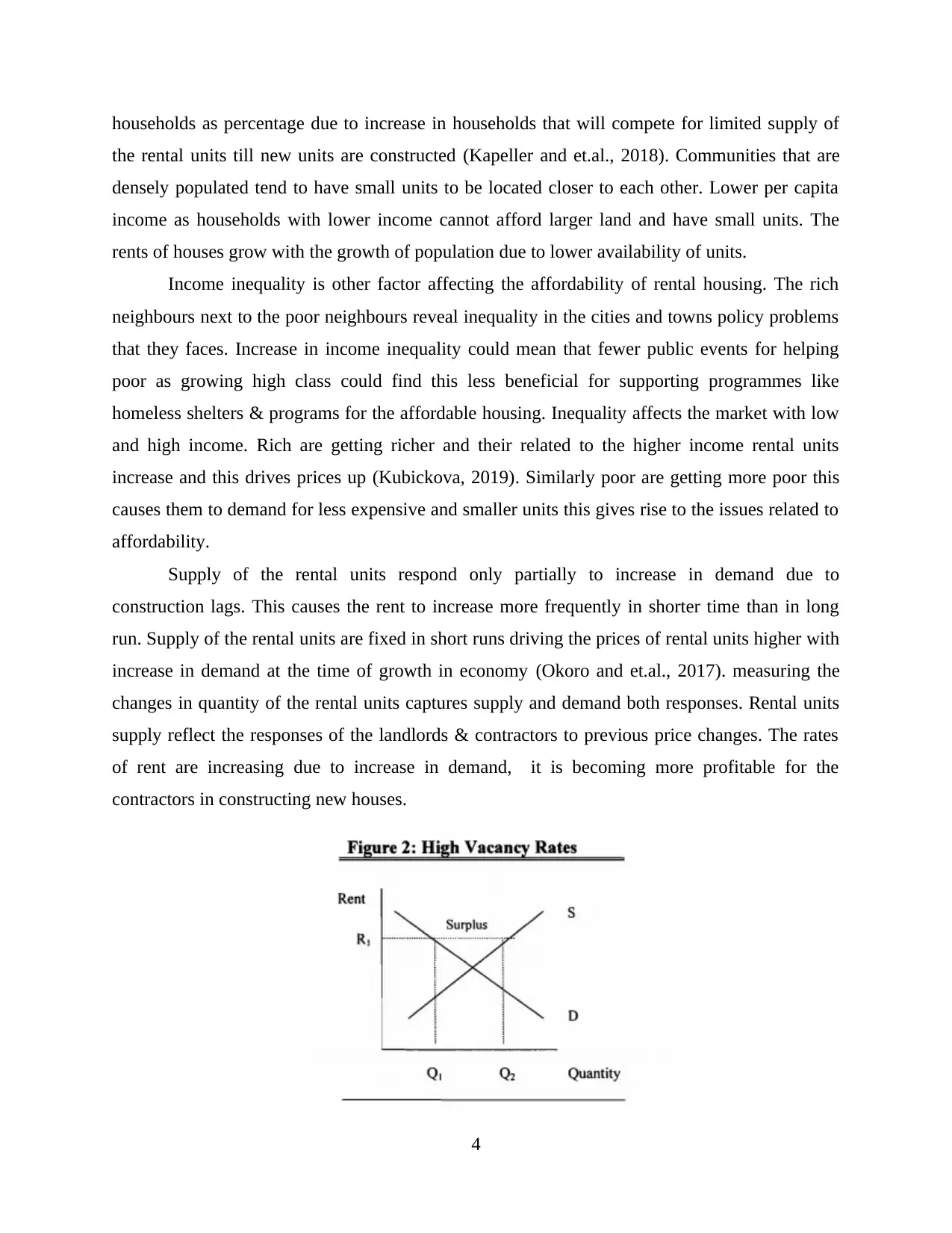
households as percentage due to increase in households that will compete for limited supply of
the rental units till new units are constructed (Kapeller and et.al., 2018). Communities that are
densely populated tend to have small units to be located closer to each other. Lower per capita
income as households with lower income cannot afford larger land and have small units. The
rents of houses grow with the growth of population due to lower availability of units.
Income inequality is other factor affecting the affordability of rental housing. The rich
neighbours next to the poor neighbours reveal inequality in the cities and towns policy problems
that they faces. Increase in income inequality could mean that fewer public events for helping
poor as growing high class could find this less beneficial for supporting programmes like
homeless shelters & programs for the affordable housing. Inequality affects the market with low
and high income. Rich are getting richer and their related to the higher income rental units
increase and this drives prices up (Kubickova, 2019). Similarly poor are getting more poor this
causes them to demand for less expensive and smaller units this gives rise to the issues related to
affordability.
Supply of the rental units respond only partially to increase in demand due to
construction lags. This causes the rent to increase more frequently in shorter time than in long
run. Supply of the rental units are fixed in short runs driving the prices of rental units higher with
increase in demand at the time of growth in economy (Okoro and et.al., 2017). measuring the
changes in quantity of the rental units captures supply and demand both responses. Rental units
supply reflect the responses of the landlords & contractors to previous price changes. The rates
of rent are increasing due to increase in demand, it is becoming more profitable for the
contractors in constructing new houses.
4
the rental units till new units are constructed (Kapeller and et.al., 2018). Communities that are
densely populated tend to have small units to be located closer to each other. Lower per capita
income as households with lower income cannot afford larger land and have small units. The
rents of houses grow with the growth of population due to lower availability of units.
Income inequality is other factor affecting the affordability of rental housing. The rich
neighbours next to the poor neighbours reveal inequality in the cities and towns policy problems
that they faces. Increase in income inequality could mean that fewer public events for helping
poor as growing high class could find this less beneficial for supporting programmes like
homeless shelters & programs for the affordable housing. Inequality affects the market with low
and high income. Rich are getting richer and their related to the higher income rental units
increase and this drives prices up (Kubickova, 2019). Similarly poor are getting more poor this
causes them to demand for less expensive and smaller units this gives rise to the issues related to
affordability.
Supply of the rental units respond only partially to increase in demand due to
construction lags. This causes the rent to increase more frequently in shorter time than in long
run. Supply of the rental units are fixed in short runs driving the prices of rental units higher with
increase in demand at the time of growth in economy (Okoro and et.al., 2017). measuring the
changes in quantity of the rental units captures supply and demand both responses. Rental units
supply reflect the responses of the landlords & contractors to previous price changes. The rates
of rent are increasing due to increase in demand, it is becoming more profitable for the
contractors in constructing new houses.
4
⊘ This is a preview!⊘
Do you want full access?
Subscribe today to unlock all pages.

Trusted by 1+ million students worldwide
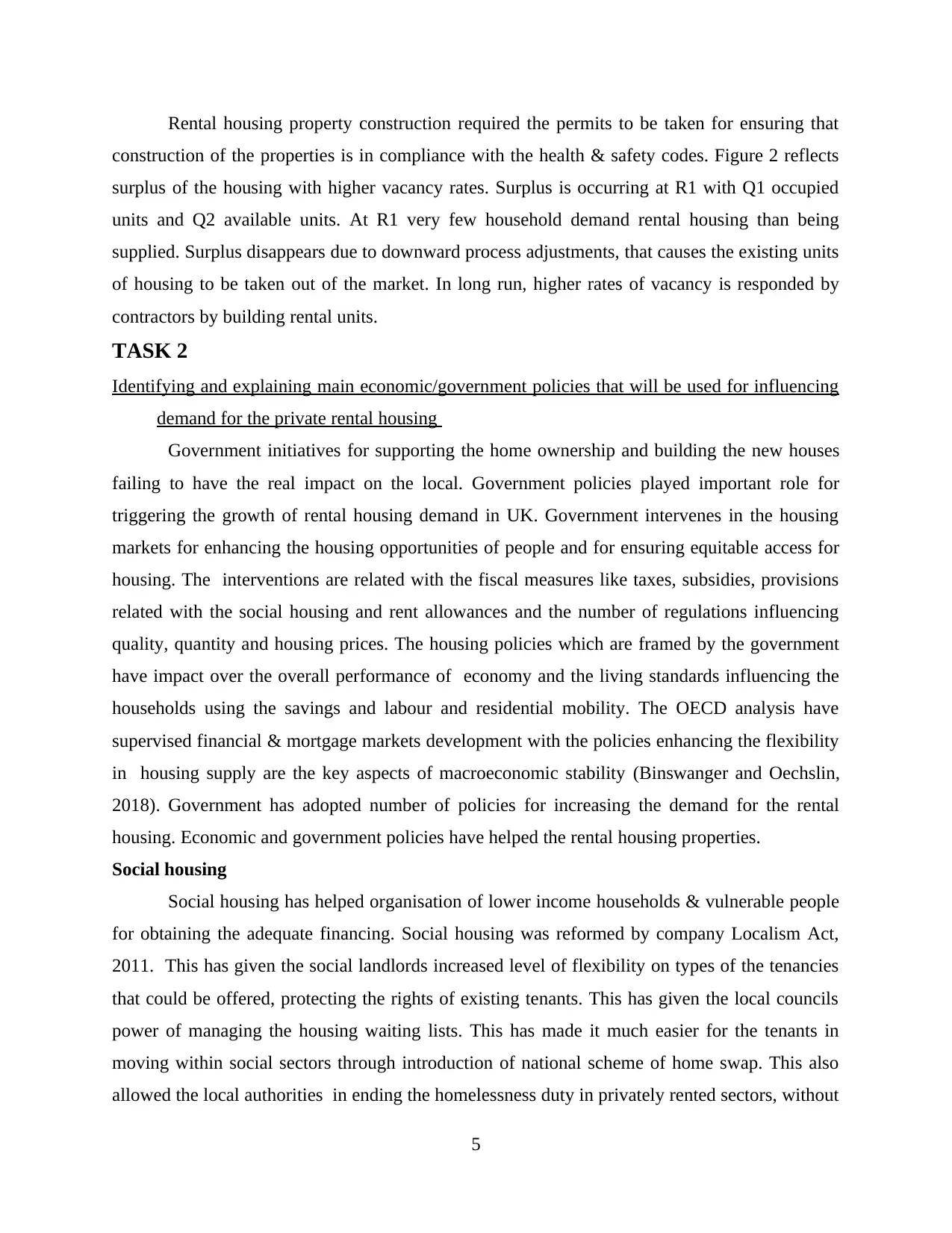
Rental housing property construction required the permits to be taken for ensuring that
construction of the properties is in compliance with the health & safety codes. Figure 2 reflects
surplus of the housing with higher vacancy rates. Surplus is occurring at R1 with Q1 occupied
units and Q2 available units. At R1 very few household demand rental housing than being
supplied. Surplus disappears due to downward process adjustments, that causes the existing units
of housing to be taken out of the market. In long run, higher rates of vacancy is responded by
contractors by building rental units.
TASK 2
Identifying and explaining main economic/government policies that will be used for influencing
demand for the private rental housing
Government initiatives for supporting the home ownership and building the new houses
failing to have the real impact on the local. Government policies played important role for
triggering the growth of rental housing demand in UK. Government intervenes in the housing
markets for enhancing the housing opportunities of people and for ensuring equitable access for
housing. The interventions are related with the fiscal measures like taxes, subsidies, provisions
related with the social housing and rent allowances and the number of regulations influencing
quality, quantity and housing prices. The housing policies which are framed by the government
have impact over the overall performance of economy and the living standards influencing the
households using the savings and labour and residential mobility. The OECD analysis have
supervised financial & mortgage markets development with the policies enhancing the flexibility
in housing supply are the key aspects of macroeconomic stability (Binswanger and Oechslin,
2018). Government has adopted number of policies for increasing the demand for the rental
housing. Economic and government policies have helped the rental housing properties.
Social housing
Social housing has helped organisation of lower income households & vulnerable people
for obtaining the adequate financing. Social housing was reformed by company Localism Act,
2011. This has given the social landlords increased level of flexibility on types of the tenancies
that could be offered, protecting the rights of existing tenants. This has given the local councils
power of managing the housing waiting lists. This has made it much easier for the tenants in
moving within social sectors through introduction of national scheme of home swap. This also
allowed the local authorities in ending the homelessness duty in privately rented sectors, without
5
construction of the properties is in compliance with the health & safety codes. Figure 2 reflects
surplus of the housing with higher vacancy rates. Surplus is occurring at R1 with Q1 occupied
units and Q2 available units. At R1 very few household demand rental housing than being
supplied. Surplus disappears due to downward process adjustments, that causes the existing units
of housing to be taken out of the market. In long run, higher rates of vacancy is responded by
contractors by building rental units.
TASK 2
Identifying and explaining main economic/government policies that will be used for influencing
demand for the private rental housing
Government initiatives for supporting the home ownership and building the new houses
failing to have the real impact on the local. Government policies played important role for
triggering the growth of rental housing demand in UK. Government intervenes in the housing
markets for enhancing the housing opportunities of people and for ensuring equitable access for
housing. The interventions are related with the fiscal measures like taxes, subsidies, provisions
related with the social housing and rent allowances and the number of regulations influencing
quality, quantity and housing prices. The housing policies which are framed by the government
have impact over the overall performance of economy and the living standards influencing the
households using the savings and labour and residential mobility. The OECD analysis have
supervised financial & mortgage markets development with the policies enhancing the flexibility
in housing supply are the key aspects of macroeconomic stability (Binswanger and Oechslin,
2018). Government has adopted number of policies for increasing the demand for the rental
housing. Economic and government policies have helped the rental housing properties.
Social housing
Social housing has helped organisation of lower income households & vulnerable people
for obtaining the adequate financing. Social housing was reformed by company Localism Act,
2011. This has given the social landlords increased level of flexibility on types of the tenancies
that could be offered, protecting the rights of existing tenants. This has given the local councils
power of managing the housing waiting lists. This has made it much easier for the tenants in
moving within social sectors through introduction of national scheme of home swap. This also
allowed the local authorities in ending the homelessness duty in privately rented sectors, without
5
Paraphrase This Document
Need a fresh take? Get an instant paraphrase of this document with our AI Paraphraser
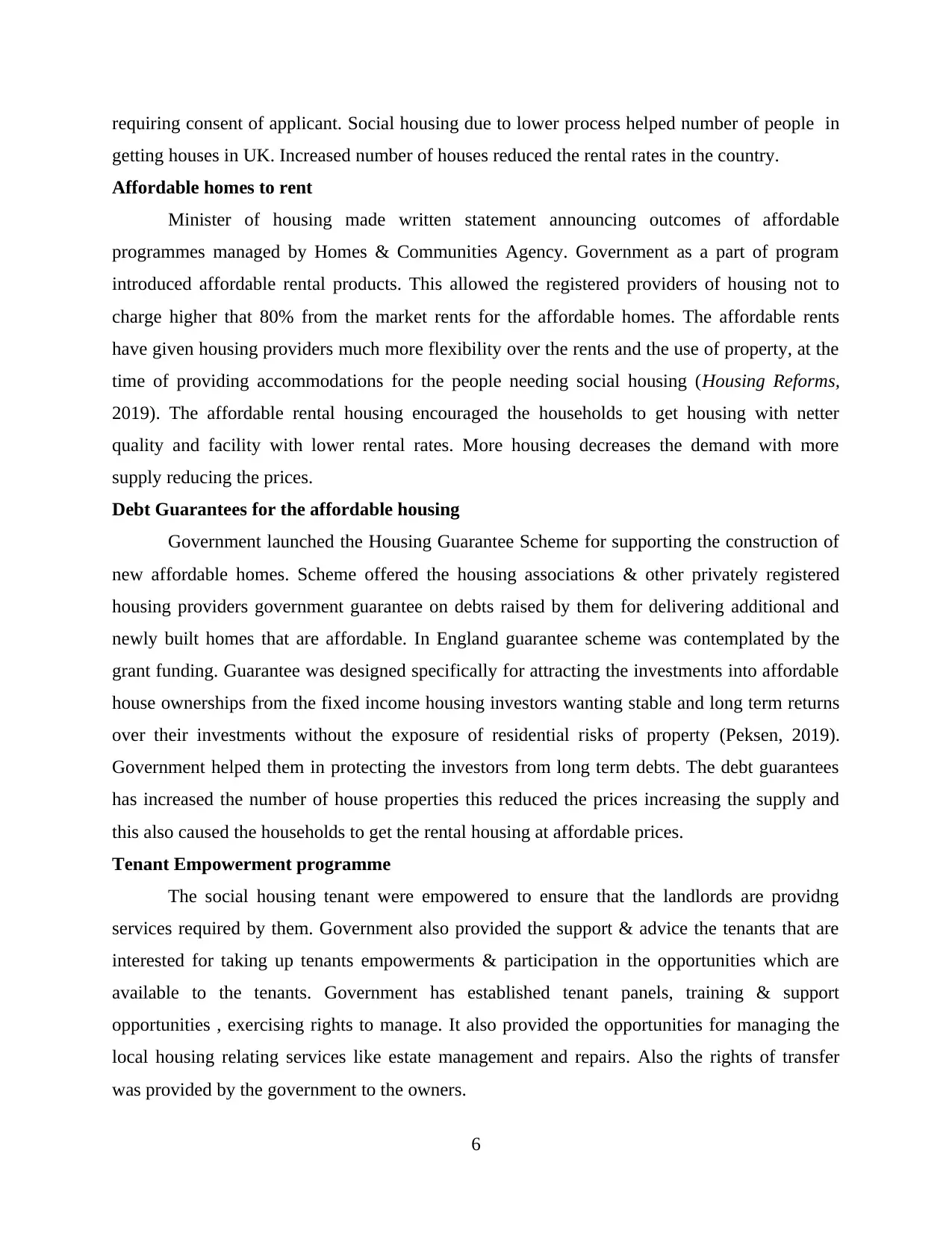
requiring consent of applicant. Social housing due to lower process helped number of people in
getting houses in UK. Increased number of houses reduced the rental rates in the country.
Affordable homes to rent
Minister of housing made written statement announcing outcomes of affordable
programmes managed by Homes & Communities Agency. Government as a part of program
introduced affordable rental products. This allowed the registered providers of housing not to
charge higher that 80% from the market rents for the affordable homes. The affordable rents
have given housing providers much more flexibility over the rents and the use of property, at the
time of providing accommodations for the people needing social housing (Housing Reforms,
2019). The affordable rental housing encouraged the households to get housing with netter
quality and facility with lower rental rates. More housing decreases the demand with more
supply reducing the prices.
Debt Guarantees for the affordable housing
Government launched the Housing Guarantee Scheme for supporting the construction of
new affordable homes. Scheme offered the housing associations & other privately registered
housing providers government guarantee on debts raised by them for delivering additional and
newly built homes that are affordable. In England guarantee scheme was contemplated by the
grant funding. Guarantee was designed specifically for attracting the investments into affordable
house ownerships from the fixed income housing investors wanting stable and long term returns
over their investments without the exposure of residential risks of property (Peksen, 2019).
Government helped them in protecting the investors from long term debts. The debt guarantees
has increased the number of house properties this reduced the prices increasing the supply and
this also caused the households to get the rental housing at affordable prices.
Tenant Empowerment programme
The social housing tenant were empowered to ensure that the landlords are providng
services required by them. Government also provided the support & advice the tenants that are
interested for taking up tenants empowerments & participation in the opportunities which are
available to the tenants. Government has established tenant panels, training & support
opportunities , exercising rights to manage. It also provided the opportunities for managing the
local housing relating services like estate management and repairs. Also the rights of transfer
was provided by the government to the owners.
6
getting houses in UK. Increased number of houses reduced the rental rates in the country.
Affordable homes to rent
Minister of housing made written statement announcing outcomes of affordable
programmes managed by Homes & Communities Agency. Government as a part of program
introduced affordable rental products. This allowed the registered providers of housing not to
charge higher that 80% from the market rents for the affordable homes. The affordable rents
have given housing providers much more flexibility over the rents and the use of property, at the
time of providing accommodations for the people needing social housing (Housing Reforms,
2019). The affordable rental housing encouraged the households to get housing with netter
quality and facility with lower rental rates. More housing decreases the demand with more
supply reducing the prices.
Debt Guarantees for the affordable housing
Government launched the Housing Guarantee Scheme for supporting the construction of
new affordable homes. Scheme offered the housing associations & other privately registered
housing providers government guarantee on debts raised by them for delivering additional and
newly built homes that are affordable. In England guarantee scheme was contemplated by the
grant funding. Guarantee was designed specifically for attracting the investments into affordable
house ownerships from the fixed income housing investors wanting stable and long term returns
over their investments without the exposure of residential risks of property (Peksen, 2019).
Government helped them in protecting the investors from long term debts. The debt guarantees
has increased the number of house properties this reduced the prices increasing the supply and
this also caused the households to get the rental housing at affordable prices.
Tenant Empowerment programme
The social housing tenant were empowered to ensure that the landlords are providng
services required by them. Government also provided the support & advice the tenants that are
interested for taking up tenants empowerments & participation in the opportunities which are
available to the tenants. Government has established tenant panels, training & support
opportunities , exercising rights to manage. It also provided the opportunities for managing the
local housing relating services like estate management and repairs. Also the rights of transfer
was provided by the government to the owners.
6
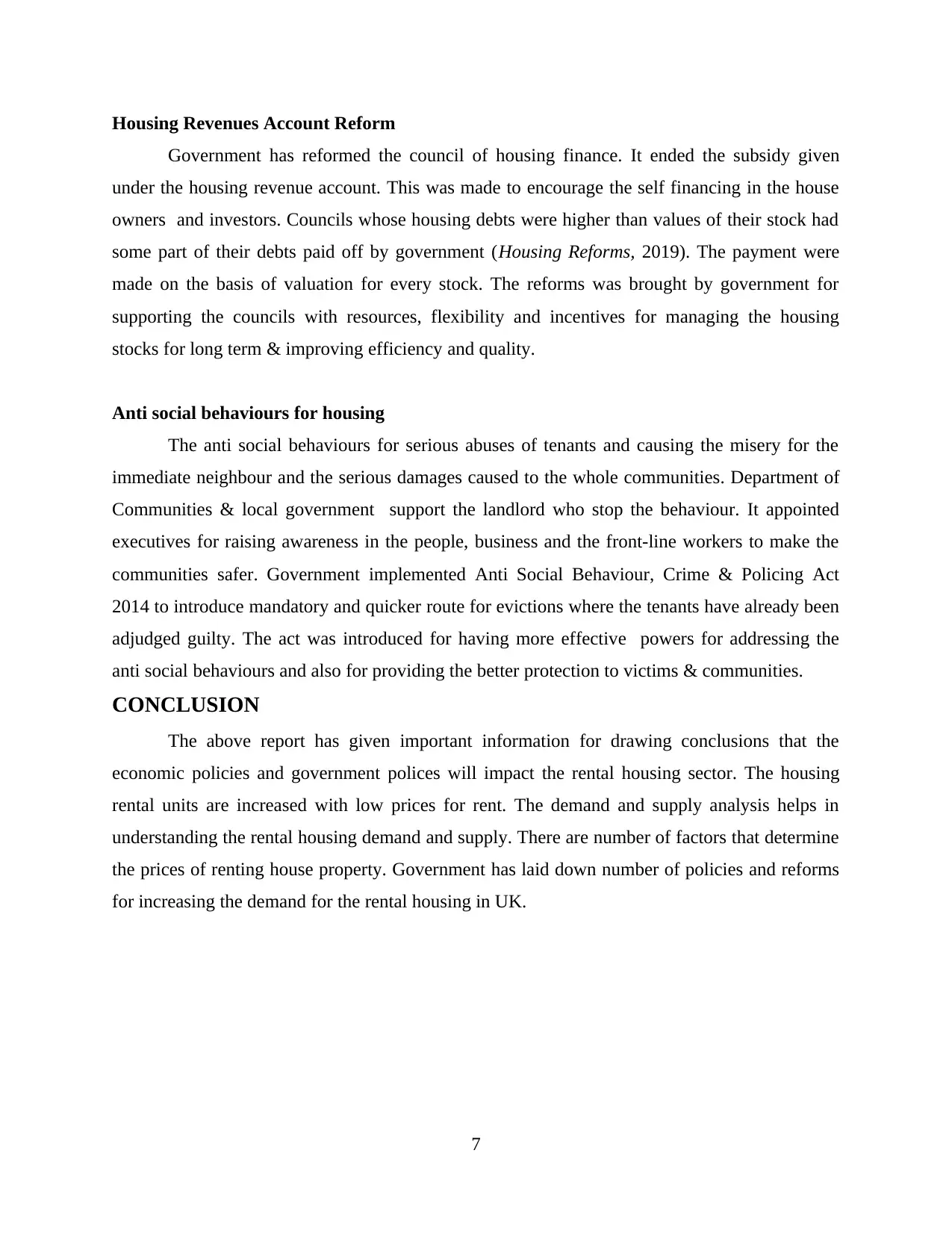
Housing Revenues Account Reform
Government has reformed the council of housing finance. It ended the subsidy given
under the housing revenue account. This was made to encourage the self financing in the house
owners and investors. Councils whose housing debts were higher than values of their stock had
some part of their debts paid off by government (Housing Reforms, 2019). The payment were
made on the basis of valuation for every stock. The reforms was brought by government for
supporting the councils with resources, flexibility and incentives for managing the housing
stocks for long term & improving efficiency and quality.
Anti social behaviours for housing
The anti social behaviours for serious abuses of tenants and causing the misery for the
immediate neighbour and the serious damages caused to the whole communities. Department of
Communities & local government support the landlord who stop the behaviour. It appointed
executives for raising awareness in the people, business and the front-line workers to make the
communities safer. Government implemented Anti Social Behaviour, Crime & Policing Act
2014 to introduce mandatory and quicker route for evictions where the tenants have already been
adjudged guilty. The act was introduced for having more effective powers for addressing the
anti social behaviours and also for providing the better protection to victims & communities.
CONCLUSION
The above report has given important information for drawing conclusions that the
economic policies and government polices will impact the rental housing sector. The housing
rental units are increased with low prices for rent. The demand and supply analysis helps in
understanding the rental housing demand and supply. There are number of factors that determine
the prices of renting house property. Government has laid down number of policies and reforms
for increasing the demand for the rental housing in UK.
7
Government has reformed the council of housing finance. It ended the subsidy given
under the housing revenue account. This was made to encourage the self financing in the house
owners and investors. Councils whose housing debts were higher than values of their stock had
some part of their debts paid off by government (Housing Reforms, 2019). The payment were
made on the basis of valuation for every stock. The reforms was brought by government for
supporting the councils with resources, flexibility and incentives for managing the housing
stocks for long term & improving efficiency and quality.
Anti social behaviours for housing
The anti social behaviours for serious abuses of tenants and causing the misery for the
immediate neighbour and the serious damages caused to the whole communities. Department of
Communities & local government support the landlord who stop the behaviour. It appointed
executives for raising awareness in the people, business and the front-line workers to make the
communities safer. Government implemented Anti Social Behaviour, Crime & Policing Act
2014 to introduce mandatory and quicker route for evictions where the tenants have already been
adjudged guilty. The act was introduced for having more effective powers for addressing the
anti social behaviours and also for providing the better protection to victims & communities.
CONCLUSION
The above report has given important information for drawing conclusions that the
economic policies and government polices will impact the rental housing sector. The housing
rental units are increased with low prices for rent. The demand and supply analysis helps in
understanding the rental housing demand and supply. There are number of factors that determine
the prices of renting house property. Government has laid down number of policies and reforms
for increasing the demand for the rental housing in UK.
7
⊘ This is a preview!⊘
Do you want full access?
Subscribe today to unlock all pages.

Trusted by 1+ million students worldwide
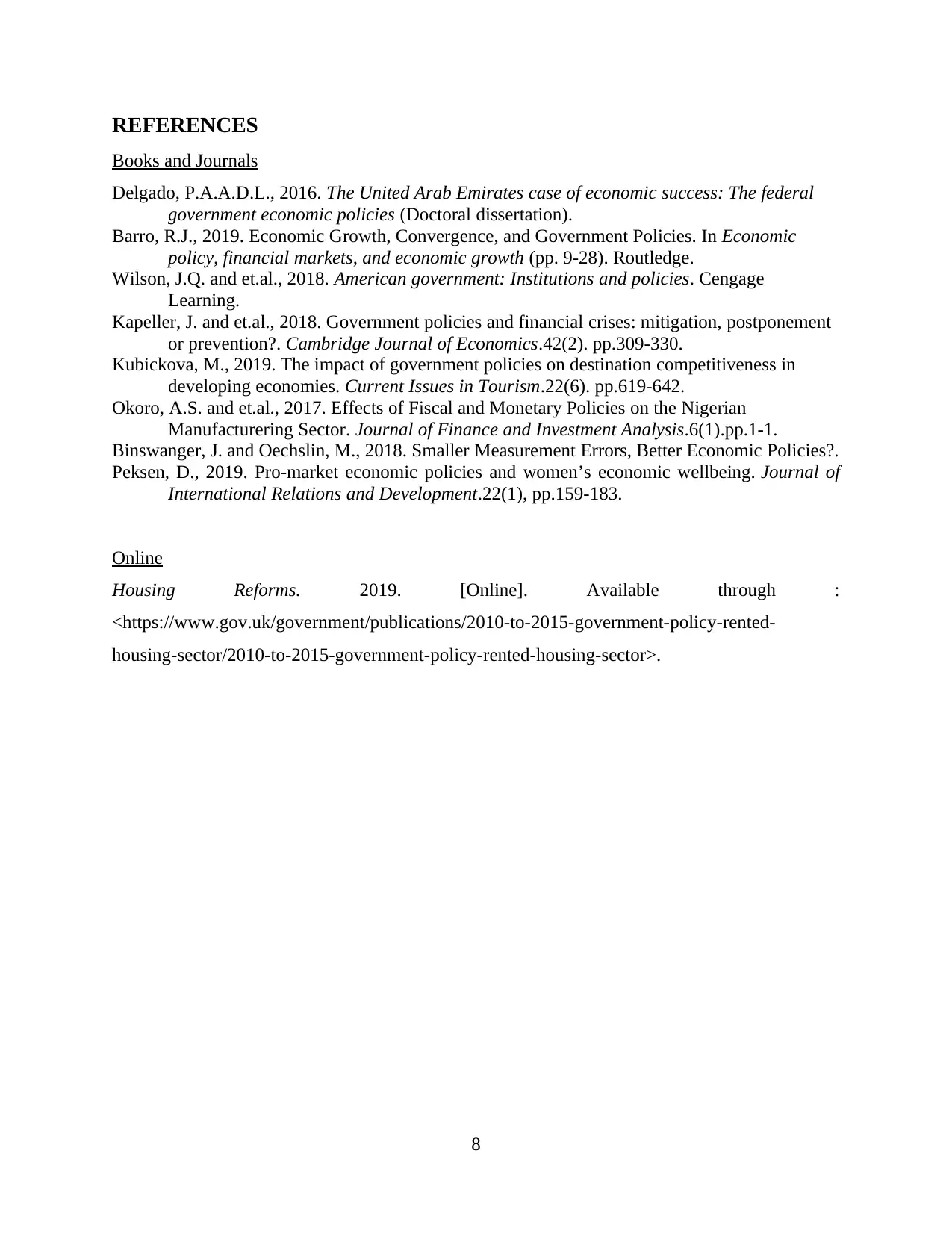
REFERENCES
Books and Journals
Delgado, P.A.A.D.L., 2016. The United Arab Emirates case of economic success: The federal
government economic policies (Doctoral dissertation).
Barro, R.J., 2019. Economic Growth, Convergence, and Government Policies. In Economic
policy, financial markets, and economic growth (pp. 9-28). Routledge.
Wilson, J.Q. and et.al., 2018. American government: Institutions and policies. Cengage
Learning.
Kapeller, J. and et.al., 2018. Government policies and financial crises: mitigation, postponement
or prevention?. Cambridge Journal of Economics.42(2). pp.309-330.
Kubickova, M., 2019. The impact of government policies on destination competitiveness in
developing economies. Current Issues in Tourism.22(6). pp.619-642.
Okoro, A.S. and et.al., 2017. Effects of Fiscal and Monetary Policies on the Nigerian
Manufacturering Sector. Journal of Finance and Investment Analysis.6(1).pp.1-1.
Binswanger, J. and Oechslin, M., 2018. Smaller Measurement Errors, Better Economic Policies?.
Peksen, D., 2019. Pro-market economic policies and women’s economic wellbeing. Journal of
International Relations and Development.22(1), pp.159-183.
Online
Housing Reforms. 2019. [Online]. Available through :
<https://www.gov.uk/government/publications/2010-to-2015-government-policy-rented-
housing-sector/2010-to-2015-government-policy-rented-housing-sector>.
8
Books and Journals
Delgado, P.A.A.D.L., 2016. The United Arab Emirates case of economic success: The federal
government economic policies (Doctoral dissertation).
Barro, R.J., 2019. Economic Growth, Convergence, and Government Policies. In Economic
policy, financial markets, and economic growth (pp. 9-28). Routledge.
Wilson, J.Q. and et.al., 2018. American government: Institutions and policies. Cengage
Learning.
Kapeller, J. and et.al., 2018. Government policies and financial crises: mitigation, postponement
or prevention?. Cambridge Journal of Economics.42(2). pp.309-330.
Kubickova, M., 2019. The impact of government policies on destination competitiveness in
developing economies. Current Issues in Tourism.22(6). pp.619-642.
Okoro, A.S. and et.al., 2017. Effects of Fiscal and Monetary Policies on the Nigerian
Manufacturering Sector. Journal of Finance and Investment Analysis.6(1).pp.1-1.
Binswanger, J. and Oechslin, M., 2018. Smaller Measurement Errors, Better Economic Policies?.
Peksen, D., 2019. Pro-market economic policies and women’s economic wellbeing. Journal of
International Relations and Development.22(1), pp.159-183.
Online
Housing Reforms. 2019. [Online]. Available through :
<https://www.gov.uk/government/publications/2010-to-2015-government-policy-rented-
housing-sector/2010-to-2015-government-policy-rented-housing-sector>.
8
1 out of 10
Related Documents
Your All-in-One AI-Powered Toolkit for Academic Success.
+13062052269
info@desklib.com
Available 24*7 on WhatsApp / Email
![[object Object]](/_next/static/media/star-bottom.7253800d.svg)
Unlock your academic potential
Copyright © 2020–2025 A2Z Services. All Rights Reserved. Developed and managed by ZUCOL.





